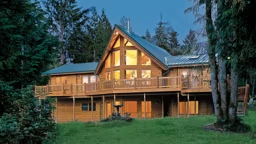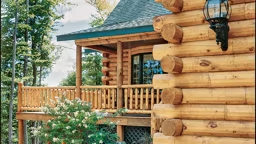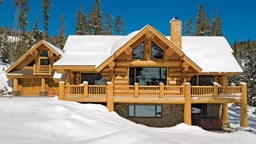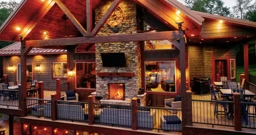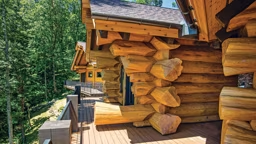Although the particular wood species you choose for your logs is irrelevant to the success of your home, the color and grain of the wood contribute substantially to a certain look. More important than species is the log's ability to perform its role in your house. Logs that span window and door openings, for example, must be able to support greater weight than logs that are simply stacked one on top of the other. One way to ensure that the logs destined for your home are up to the job is to buy logs that are graded for structural use. Members of the Log Homes Council (LHC) are required to have their logs graded either by the council's grading program or by Timber Products Inspection (TPI), an independent company. TPI also grades logs for some non-LHC members and can even be hired to grade the logs in your kit if they are produced by a company that doesn't grade. Ask about log grading when choosing a company.
Pine
Pine has good tensile strength and remains true and straight. Some types of pine have loads of character in the grain, too. This species is among the most prevalent of choices for log homes, because it's so plentiful, can be found in a wide variety of colors and grains and is often significantly less expensive than competing species. Pine--when properly maintained--will stay strong , but is not often used for entire home construction.

Subspecies of pine include:
Lodgepole Pine
Lodgepole pine gets its name from the British Columbian First Nations peoples who used this wood for poles in lodges, buildings and homes. Each spring, they would strip off long ribbons of the inner bark—also known as “noodles"—and eat it fresh, seasoned only with sugar occasionally. Lodgepole’s pitch was also boiled with animal fat and used as a poultice for joint pain and arthritis. Lodgepole is most often used for paneling, doors, windows, fence posts and furniture.
Ponderosa Pine
The large, straight-trunked Ponderosa pine has blackish or dark red-brown bark. This is a yellow pine with yellow or light brown heartwood. Ponderosa pine is often used for decks, cabinets, exterior trim, siding, millwork and paneling.
Red Pine
Red pine, also known as Norway Pine, is a tall, straight tree, often averaging 80 feet tall. This softwood species is naturally found in the northern Great Lakes region. Red pine is characterized by its “black knots” caused by dead branches remaining attached to the tree for years. During drying, these knots shrink and fall out, leaving behind a knot hole. “Red knots” are created in a similar manner from live branches, and do not fall out.
White Pine
White pine’s popularity comes from a beautiful grain that is easy to stain. This lightweight yet stable wood provides for strong insulation, and is resistant to shrinkage. Due to the tree’s large size, it is often used for exterior walls in log cabins and log homes.
Douglas Fir
Douglas fir is a western species whose tones vary from rosy red to yellow, depending on age. Because the douglas fir tree grows to majestic heights, the wood offers an excellent strength-to-weight ratio that makes it a fine choice for log homes built in areas prone to storms, high winds and earthquakes. It's durability makes it marvelous for use in lengthy spans. It can be pricey, but high-density Douglas fir is strong and a good choice for structural uses. It holds its true straightness for generations and is ideal for homes that will be passed down to your appreciative children and grandchildren.
According to Jack Cherry, wood buyer for
Honest Abe Log Homes, “Its superior strength to weight ratio makes the douglas fir ideally suited for structural beams,” he said, adding that it also provides excellent nail and plate holding capacity that is necessary in rafter design.
Spruce
Native to New England but also available in the Midwest, South and West, spruce is classified as red, white or black, although there's little difference in color, which trends toward creamy white or pale yellowish brown. Although easy to work with, spruce can yield unexpected results when stain is applied due to the wood's closed pore structure. However, spruce responds well to gel stain, toner or a sanding sealer. Spruce has many construction characteristics to recommend it: It can be dried easily, holds nails well, and is easy to drill, saw and plane. Another plus to working with spruce is that it generally doesn’t warp or split.
Subspecies of spruce include:
White Spruce
White spruce, known for its fine texture and straight grain, is typically a yellowish-white or creamy in color.
Engelmann Spruce
Western subspecies Engelmann spruce is softer and lighter, both in weight and color. Some log home companies will offer Engelmann spruce along with lodgepole pine due to their tendency to grow well together in drier areas. The lion’s share of Engelmann spruce lumber is produced in Idaho, Colorado and Montana.
Cedar
Ah, the wonder of cedar’s marvelous scent! Many are the homeowners who decide not to seal the interior of a cedar home so they can continue enjoying the welcoming aroma. Since its lovely grain and color--ranging from light brown to deep-reddish brown, depending on subspecies--radiate from the center of the log, cedar is often displayed with exposed ends. Because it doesn’t grow just anywhere, cost may vary across the continent. Cedar offers variety in texture and tones, with minimal shrinkage.
Cedar is considered one of the most insect-tolerant and rot-resistant varieties. Additionally, cedar's low moisture content keeps cracking and checking at bay.
Oak
The mighty oak has never been more popular. Oak is a durable hardwood with warm colors and a rich grain.
Because of its tensile strength, soothing neutral color and wonderful grain--which can range from light to a greyish dark brown--this popular wood species often goes unstained. While not as plentiful as pine due to a slow growth pattern and over-harvesting in generations past, oak’s cost is offset by its durability. One of the heavier species, it's also very resistant to heartwood decay.
Cypress
Cypress is a light- to mid-weight species that ranges from medium yellow brown to dark amber brown, based on age. It features a straight grain with fine texture. Cypress wood is durable, insect-resistant, decay-resistant, and smells similar to cedar, making it a popular choice of wood species for log homes.
Cypress trees grow naturally in in the southern region of the United States. There are about 13 species of these tall evergreen trees. The trees thrive in warmer climates, which is why the native bald cypress is used for all types of lumber.
Read More About Wood Species for Log Homes:











